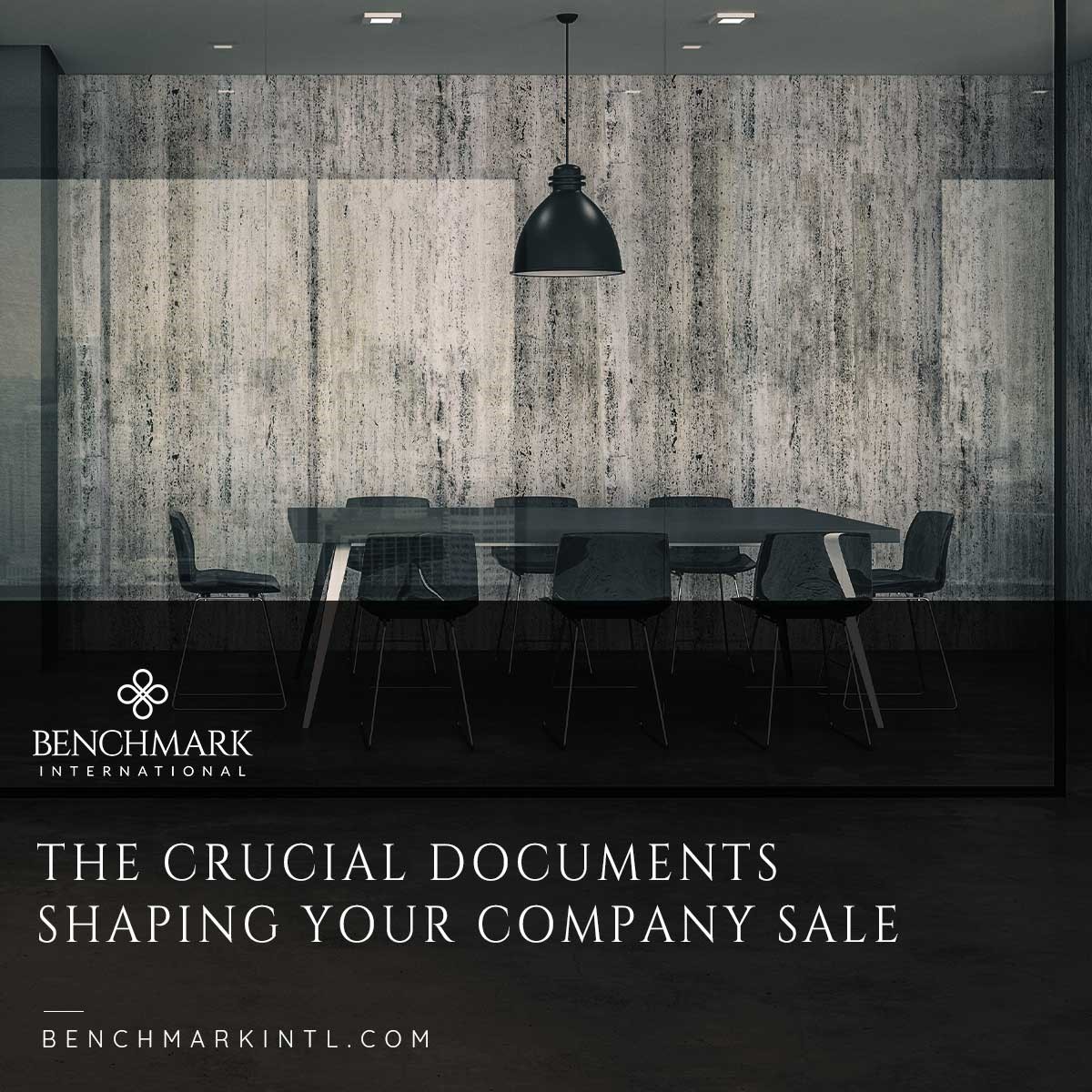
So much hard work goes into negotiating the deal and agreeing the Heads of Terms (Heads) or Letter of Intent (LOI), it’s critical the deal is properly managed, and the legal contracts fairly negotiated to ensure the deal happens!
This article provides a summary of the key transaction documents along with insights from your experienced Benchmark International deal team.
Issues List or Deal Timeline
Your advisers will often prepare a detailed Issues List (IL) shortly after the agreement of Heads. This will normally be derived from a detailed template, remodelled for your specific deal, and updated and shared with you regularly.
|
Purpose: |
To ensure the sellers are aware of all workstreams that are tracking, the work their deal team is undertaking on their behalf and their responsibilities to provide information as required. To highlight issues and bottlenecks in good time! |
|
Prepared by: |
Sell-side advisers for sell-side utilisation (although sometimes shared). |
|
Key matters: |
Key dates & milestones, key aspects relating to financial due diligence (FDD), legal due diligence (LDD) & commercial due diligence (CDD), tax due diligence, completion processes etc. |
|
Insights: |
Can be overwhelming for some clients, but remember, forewarned is forearmed. |
Information Request Lists (IRLs) or Due Diligence Wishlists
Once Heads have been signed, you can expect to receive a series of information requests from the buy-side, following which your deal team will map out the virtual data room (VDR), where the responses and information will be securely held.
|
Purpose: |
To provide the buyer and their advisers with the information they require to understand your company. |
|
Prepared by: |
Buyer’s lawyers and due diligence (DD) providers. |
|
Key matters: |
The LDD wishlist will be a lengthy standard document and managed on your behalf by your lawyers, who will work alongside you to check and upload the answers and information to the VDR. The FDD wishlist should be tailored to your company, and the answers you provide will be in the form of accounts and analysis that your accountant will typically assist with before being added to the VDR. There are likely to be several FDD IRLs, sometimes from different parties. CDD will vary from deal to deal and is more often required by financial buyers who need to build their knowledge of your company, its customers, and markets. |
|
Insights: |
Gone are the days of lever-arch files, and sellers being advised to keep a copy of everything they have provided. VDRs are now used in every transaction and are an efficient and secure means of progressing the DD phase of a sale. Start early, put time aside and approach these IRLs in manageable chunks. Your deal team will work closely with you on the FDD, and your lawyers will normally take the lead on the LDD, all aiming to ensure the process does not become overwhelming. Discuss volume concerns early with your lawyer and deal team. We have seen IRLs many times - sometimes there may be another way, but sometimes the answer will be ‘no!’ |
Share Purchase Agreement (SPA) [Stock Purchase Agreement in the USA]
The SPA is, by far, the most important, and weightiest, document in the process. Its arrival, typically after the buyer has concluded its due diligence investigations, will signal the start of the ‘business end’ of the process.
|
Purpose: |
The SPA is the contract by which the sellers agree to sell, and the buyer agrees to buy, the shares in your company. It will comprise the key commercial terms of the deal along with your contractual rights, obligations, and liabilities in relation to the sale. |
|
Prepared by: |
Buyer’s lawyers. |
|
Key matters: |
Purchase price – how much, when, and key conditions. Warranties – as a buyer takes the company ‘warts and all’, it’s customary for buyers to seek contractual assurances from sellers in the form of ‘warranties’. The warranties will comprise a series of factual statements relating to all aspects of the company’s business and affairs. Promises, if you like. These vary little from one draft SPA to the next. For example, “the sellers warrant, to the best of their knowledge and belief, that there are no pending legal claims…”. Your lawyers will work with you on a Disclosure Letter (see below), which is your opportunity to disclose relevant facts and information that counter the warranties, aimed at limiting any claims against them. Claims limits – contractual hurdles and procedural requirements will be incorporated which aim to restrict the buyer's ability to bring a warranty claim, or to limit the amount the buyer can recover in respect of a claim. Reference will be made to ‘de minimis’, being the starting point for individual claims, and ‘baskets’, being the threshold that would need to be reached before any claims can be made. For the sellers, the higher the limits, the better! Price adjustment mechanisms – depending on whether the price has been derived from the company’s value at completion (using a ‘completion accounts mechanism’) or by reference to a specific set of accounts drawn up to a date before completion (using a ‘locked box mechanism’). This is negotiated in conjunction with your deal team and your accountants. Indemnities – in contrast to the legal effect of a warranty, an indemnity is a more draconian provision that provides a right of return to a buyer in relation to certain specified facts. For warranty claims, a buyer would need to prove financial loss, which is not the case with indemnities. Indemnities are normally only included where the buyer has identified specific areas of risk as part of its due diligence. For example, third-party claims for damage or personal injury resulting from a known contamination event. Tax indemnity – a standard document, negotiated in conjunction with your accountants or tax advisers, allocating responsibility to the sellers for pre-existing tax-related liabilities. |
|
Insights: |
The first draft of the SPA from the buyer’s lawyers will normally be prepared from a template, will not have the deal numbers added, and will not have any detail arising from the FDD and LDD. In some senses, it’s just an initial ‘pitch’ from the buyer’s lawyers with the intention of commencing key discussions with your lawyers. Your lawyer will most likely tell you to ignore the first draft! Both sets of lawyers will lock horns over key issues, and it’s normal for your lawyers to share with you their frustrations with ‘the other side’. Remember this is ‘all in the game’ and try not to allow the perceived stubbornness of the buyer’s lawyers to tarnish your relationship with, or perception of, the buyers themselves. Everyone knows the red lines here! The signing and exchange of the SPA will signal the legal completion of the deal – time to ‘shake hands’ with the buyer and put any stresses and strains that have arisen throughout this process behind you. |
Disclosure Letter
A critical extension to the SPA is the disclosure process, through the preparation of a comprehensive Disclosure Letter. It is customary that the buyer accepts there will be no actionable claim for breach of warranty if adequate details of the facts, matters or circumstances giving rise to the breach have been set out properly in the Disclosure Letter.
|
Purpose: |
For the sellers – to reduce the likelihood of any actionable claim against the warranties. For the buyer – a significant fact-finding exercise. |
|
Prepared by: |
Seller’s lawyers, with significant input from the sellers. |
|
Key matters: |
Any matter that is contained in the warranties that needs to be disclosed. For example, “The company is presently a defendant in a lawsuit…”. |
|
Insights: |
This is going to be hard work and is likely to take several iterations with your lawyers before it’s ready to be released to the buyer. As with the DD, start early. The Disclosure Letter is your opportunity to put the buyer on notice of anything they need to know to reduce your exposure to possible future warranty claims. It’s critical that you give this your full attention. Take full advantage of the opportunity to get everything on the table with your lawyer, and take your lawyer’s advice as to what should and should not be included. Buyers don’t like surprises. If there are significant matters that are likely to arise during the disclosure process, think carefully about how to broach these with the buyer ahead of the disclosure process. |
Employment Contracts or Service Agreements
As the role of the sellers is likely to change following completion, new employment contracts (for key employees) or service agreements (where there is a switch to a consultancy role) will be put in place.
|
Purpose: |
Normal HR protocol. |
|
Prepared by: |
Buyer’s lawyers, or more frequently the lawyer’s in-house legal team — who tend to be distanced from the commercial and legal aspects of the deal, which can often cause a disconnect. |
|
Key matters: |
Compensation (or remuneration), hours of work, annual leave, and other benefits. Term and notice periods. ‘Leaver’ provisions – where a deal has contingent consideration or retained or rolled-over shareholdings, there will need to be agreement on the basis a seller can leave without forfeiting these (‘good leaver’ – normally ‘by agreement’ or ‘death’) and where they will forfeit (‘bad leaver’ – normally for ‘gross misconduct’). |
|
Insights: |
Employment contracts seem to arrive very late in the day, too late in the opinion of most sellers, and often don’t accurately reflect the discussions the sellers may have had directly with the buyer. So, there is always work to be done. Patience is a must! |
The process and its legal documentation are designed to ensure the sellers receive the agreed monies and keep them over time.
Your choice of lawyer is critical. Your deal team will have a panel of lawyers they are used to working with but will be also happy to work closely with an experienced corporate lawyer of your choice.

Author
Will Sloan
Senior Associate
Benchmark International
T: +44 (0) 161 359 4400
E: WSloan@benchmarkintl.com
Europe: Michael Lawrie at +44 (0) 161 359 4400 / Lawrie@BenchmarkIntl.com
Americas: Sam Smoot at +1 (813) 898 2350 / Smoot@BenchmarkIntl.com
Africa: Anthony McCardle at +27 21 300 2055 / McCardle@BenchmarkIntl.com
ABOUT BENCHMARK INTERNATIONAL:
Benchmark International is a global M&A firm that provides business owners with creative, value-maximizing solutions for growing and exiting their businesses. Benchmark International has handled over $10 billion in transaction value across various industries from offices across the world. With decades of M&A experience, Benchmark International’s transaction teams have assisted business owners with achieving their objectives and ensuring the continued growth of their businesses. The firm has also been named the Investment Banking Firm of the Year by The M&A Advisor and the Global M&A Network as well as the #1 Sell-side Exclusive M&A Advisor in the World by Pitchbook’s Global League Tables.
 Benchmark International
Benchmark International  Benchmark International
Benchmark International 





